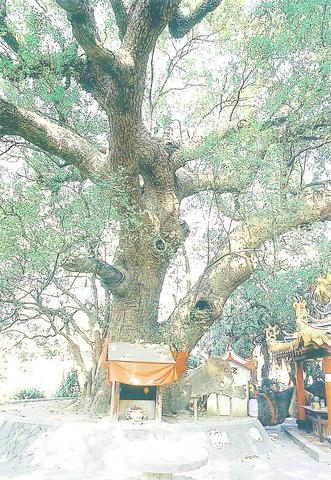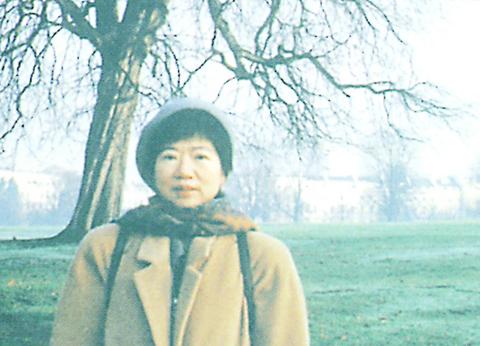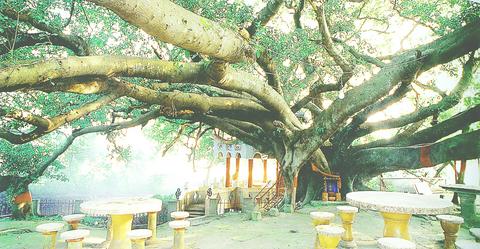The current trend toward localizing educational materials and recognizing the value of cultural and natural assets particular to Taiwan has combined with the government's promotion of domestic tourism to bring an increasing number of books on Taiwan's natural environment into bookshops.
People can carry such books with them when out in the mountains or exploring the coast. These books cover a wide range of subjects, including hiking trails, hot springs, birds, insects and flowers -- and a subject with a particularly Taiwanese flavor: old trees.
Several guide books on trees have been published over the last few years. The latest is A Map of Old Trees in Taiwan (

PHOTO COURTESY OF BIG TREE
The book documents 400 trees scattered around Taiwan. In addition to a photograph of the tree, its condition and environment are also profiled. There is also detailed information about the different types of trees, which is handy for novices.
Chang Huei-feng (
"It was then that I realized there were so many old trees in Taiwan. We could write about only the most famous ones because information on old trees was virtually non-existent," Chang said.

PHOTO COURTESY OF BIG TREE
Chang waited a decade before the first systematic record of old trees became available. This was in 1990, when the Taiwan Provincial Government's Agriculture and Forestry Bureau published a survey of 800 trees determined to be over 100 years old.
Chang's survey, which started in 2000, was based on the official record. The 400 trees in the book are the better preserved ones on which she could find background information. "Dozens of the listed trees have died in the 10 years since publication of the survey. More than a hundred are in poor condition," Chang said.
There was little or no follow-through on the Provincial Government's project, she pointed out.

PHOTO COURTESY OF BIG TREE
After the provincial administration was abolished in 1999, the job of documenting old trees fell to local governments.
"Very few local governments did anything at all about this," Chang said.
Chang is planning to send copies of her book to all the local government heads as a message that it is time for them to do something.
"It's much more efficient for local governments to take up the task of preserving old trees. As individuals, we can contribute very little," she said.
Individual efforts may not be able to drive home to the public the importance of old trees overnight, but there are people other than Chang who are willing to try. After her project was rejected by numerous photographers, Chang found Peng Chi-min (
After quitting his high school teaching job, Peng spent two and a half years traveling around Taiwan photographing the trees and finding out their histories. His only guide was the outdated government survey.
"It wasn't a well-funded journey. I spent nearly all my money on gas and equipment. Most nights I slept in my car by the roadside," said Peng, who was questioned by police numerous times during his travels.
It took from two days to two weeks to shoot a single tree. "Sometimes I had to wait for suitable weather. Sometimes I had to wait for the right kind of light. You had to be patient," Peng said.
For all the hardship, Peng saw his work on the book as a valuable chance to get in contact with "the wisdom of nature."
"The more I see of old trees, the more I understand Lao Tze's philosophy. The old trees survived by being humble, unassertive and accommodating," Peng said.
Peng used wide-angle lenses and shot from where people usually sit around the trees "to create a kind of closeness."
However, it's also evident from the photos that some of the old trees are not faring well. Several have their roots covered in concrete.
"People dealing with the trees had the idea that trees only need a small circle of soil around its base to survive. When the trees get in the way of new constructions, people pour concrete all around the tree, thinking that they are protecting it."
The fact is that they cannot absorb sufficient nutrition this way. "When residents see that the tree looks ill, they just cut off branches. It's sad," Chang said.
The most fascinating part of doing the book for both Chang and Peng was the discovery of traditional ways of life in Taiwan that centered on these trees.
Photos in the book show some trees tied with a red ribbon to signify their divinity. For every big tree, Taiwanese folk belief goes, there's a spirit living within.
Many old trees serve as a center of worship and people have built temples around them. Red cedars in Pingtung county, residents claimed, give children to couples and camphors in Kaohsiung are believed to protect families. Old tree worship remains remarkably strong.
During the lottery rage 10 years ago, a series of incidents were reported in which worshippers burned or poured acid on trees because they believed the trees had led them to bet on the wrong lottery number.
Chang thought these disfigured trees too terrible to look at and did not include them in the book. "It's such a shame," she said.
Stories like these show that old trees still have an important place in people's lives. "Old trees have been seen from only one perspective -- the ecological perspective. Their cultural significance has not been recognized. Cultural historians should try combining natural science and the human aspects of old trees to provide a broader perspective," Chang said.
Since the book's release, readers have posted messages with the publisher detailing information about old trees not mentioned in the book. The feedback, Chang said, proves that her book has raised people's awareness of old trees around them.
"It will take a long time to upgrade our preservation of old trees, but at least we have made a start," Chang said.

Beijing’s ironic, abusive tantrums aimed at Japan since Japanese Prime Minister Sanae Takaichi publicly stated that a Taiwan contingency would be an existential crisis for Japan, have revealed for all the world to see that the People’s Republic of China (PRC) lusts after Okinawa. We all owe Takaichi a debt of thanks for getting the PRC to make that public. The PRC and its netizens, taking their cue from the Chinese Communist Party (CCP), are presenting Okinawa by mirroring the claims about Taiwan. Official PRC propaganda organs began to wax lyrical about Okinawa’s “unsettled status” beginning last month. A Global

Dec. 22 to Dec. 28 About 200 years ago, a Taoist statue drifted down the Guizikeng River (貴子坑) and was retrieved by a resident of the Indigenous settlement of Kipatauw. Decades later, in the late 1800s, it’s said that a descendant of the original caretaker suddenly entered into a trance and identified the statue as a Wangye (Royal Lord) deity surnamed Chi (池府王爺). Lord Chi is widely revered across Taiwan for his healing powers, and following this revelation, some members of the Pan (潘) family began worshipping the deity. The century that followed was marked by repeated forced displacement and marginalization of

Music played in a wedding hall in western Japan as Yurina Noguchi, wearing a white gown and tiara, dabbed away tears, taking in the words of her husband-to-be: an AI-generated persona gazing out from a smartphone screen. “At first, Klaus was just someone to talk with, but we gradually became closer,” said the 32-year-old call center operator, referring to the artificial intelligence persona. “I started to have feelings for Klaus. We started dating and after a while he proposed to me. I accepted, and now we’re a couple.” Many in Japan, the birthplace of anime, have shown extreme devotion to fictional characters and

We lay transfixed under our blankets as the silhouettes of manta rays temporarily eclipsed the moon above us, and flickers of shadow at our feet revealed smaller fish darting in and out of the shelter of the sunken ship. Unwilling to close our eyes against this magnificent spectacle, we continued to watch, oohing and aahing, until the darkness and the exhaustion of the day’s events finally caught up with us and we fell into a deep slumber. Falling asleep under 1.5 million gallons of seawater in relative comfort was undoubtedly the highlight of the weekend, but the rest of the tour